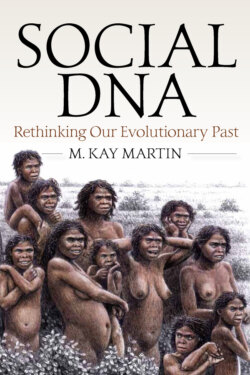Читать книгу Social DNA - M. Kay Martin - Страница 11
На сайте Литреса книга снята с продажи.
Water Drives Ecology
ОглавлениеThe course of human evolution is inextricably linked to water. Daily access to adequate drinking water is a biological imperative and the primary limiting factor that has shaped how and where ancient peoples lived and prospered. Discussion among paleoanthropologists has been focused in two principal areas: (1) water as a critical element of the early hominin habitat that accompanied arboreal abandonment and expansion into the savannas; and (2) the impact that climatic events and associated changes in water distribution and availability had on the demography and lifeways of Pleistocene populations.
The literature abounds with theories on the abandonment of arboreal life. There is general agreement, however, that the first hominins to venture from the warm, moist environment of the forest canopy did so on the margins of transitional habitats that were defined by water sources. Finlayson (2014: 22–24) surveyed the habitat elements common to known fossil sites in order to better characterize what he termed the essentials of early hominin real estate. The vast majority were found to be associated with settings that combined “shallow water, trees, and open (treeless) spaces.” Terrestrialism expanded the range and types of potential food sources for initiates, gradually converting them from tacit fruitarians into omnivores. This bipedal vanguard, commonly associated with a wide variety of Pliocene apes, is assumed in popular theories to have been followed by more advanced proto-humans that ventured farther into the surrounding countryside to procure sources of animal flesh—an accomplishment often credited with leapfrogging early hominins into the genus Homo.
Water, or the absence thereof, is seen by Boaz (1997) and Finlayson (2014) as a driver of increasing sophistication in early humans. Pleistocene climatic swings were accompanied by dramatic ecological changes, including the retreat of tropical forests, increasing aridity, and desertification. Such conditions are proposed to have selected for complex reasoning and strategies necessary for survival in the face of diminishing water supplies. Prevailing theories about life in the Pleistocene argue that early hominins, tethered as they were to sources of water, were forced to increase their mobility and geographical range, limit their group size, adopt new technologies, and/or embark on migrations to more favorable habitats for sustenance.
Such theories acknowledge the critical importance of water sources for quenching hominin thirst. But notably, they are generally silent about the extent to which rivers, lakes, marshes, and marine shorelines also contained the necessary food sources to fill their bellies. Such well-watered habitats, which support a wide variety of flora and lipid-rich fauna, were variably distributed throughout Africa and Eurasia even during the waxing and waning of glacial events. These premium habitats were theoretically capable of supporting sizeable populations on a seasonal or year-round basis. Not coincidentally, this is precisely where hominin fossils are most frequently found. This book will examine recent paleoecological research and archaeological evidence that underscores the importance of mosaic habitats and aquatic resources in early human adaptations.
The implications of well-watered habitats and resource diversity for early human social life are profound. Periods of extreme aridity did occur during the Pleistocene. Lakes and rivers in some regions did dry up. But surviving populations were necessarily opportunistic. It is equally probable that, as an alternative to settling for a Spartan existence on the arid savanna, enterprising hominins simply followed existing waterways and coastal highways to more favorable habitats, or shadowed the advance and retreat of glacial ice seeking the “ecological release” of untapped environments. This book will re-examine what we know and what we think we know about the hominin Plio-Pleistocene diet and how these assumptions color our vision of early human communities.
